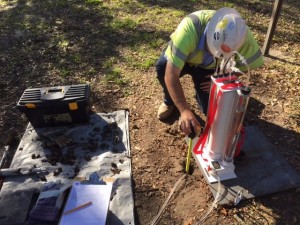 Eustis Engineering L.L.C. recently acquired a Compact Constant Head Permeameter, also known as the Amoozemeter, to add to our capability of measuring how water flows through soil.
Eustis Engineering L.L.C. recently acquired a Compact Constant Head Permeameter, also known as the Amoozemeter, to add to our capability of measuring how water flows through soil.
Eustis Engineering acquired the device because of changing regulations in zoning ordinances for the City of New Orleans.
We currently measure hydraulic conductivity (or permeability) in the laboratory, using a week-long test. This test is generally used to determine the performance of landfill caps and impermeability barriers.
The Amoozemeter is a different application of permeability testing. It determines the infiltration rates of in situ soils in the design of bioswales, dry and wet retention BMPs, and pervious pavements.
Created by Dr. Amoozegar of North Carolina State University, the Amoozemeter can help field scientists run measurements of saturated hydraulic conductivity of soils and fill material at sites that previously were challenging to measure. The Amoozemeter must be used below fill – it does not work well in gravel – and above the water table.
An Amoozemeter is composed of four constant-head tubes, a 5-liter water reservoir, a flow-measuring reservoir, a water-dissipating unit, and a base housing a three-way valve that connects the two reservoirs and the water-dissipating unit together. The Amoozemeter uses the constant head tubes to keep a constant head in the bore hole and then the water drop from the reservoirs is measured over time.
Colleen Percle performed a test run of the device in Eustis Engineering’s front yard. The device comes with an attached carrying strap for easy transportation.
“You can wear it like a backpack, so it looks like you’re a Ghostbuster,” Percle said.
Geologist DJ Benedetto, P.E., and Carlos Sitch, P.E., (Engineering, Metairie) used the Amoozemeter in February at a job site in New Orleans.
“By using these test results, the designer can accurately establish onsite infiltration parameters,” Benedetto said. “You know how much water storage you have.”
